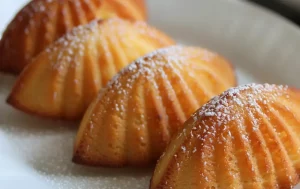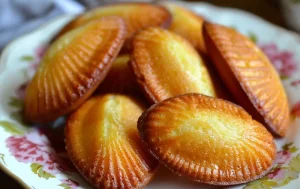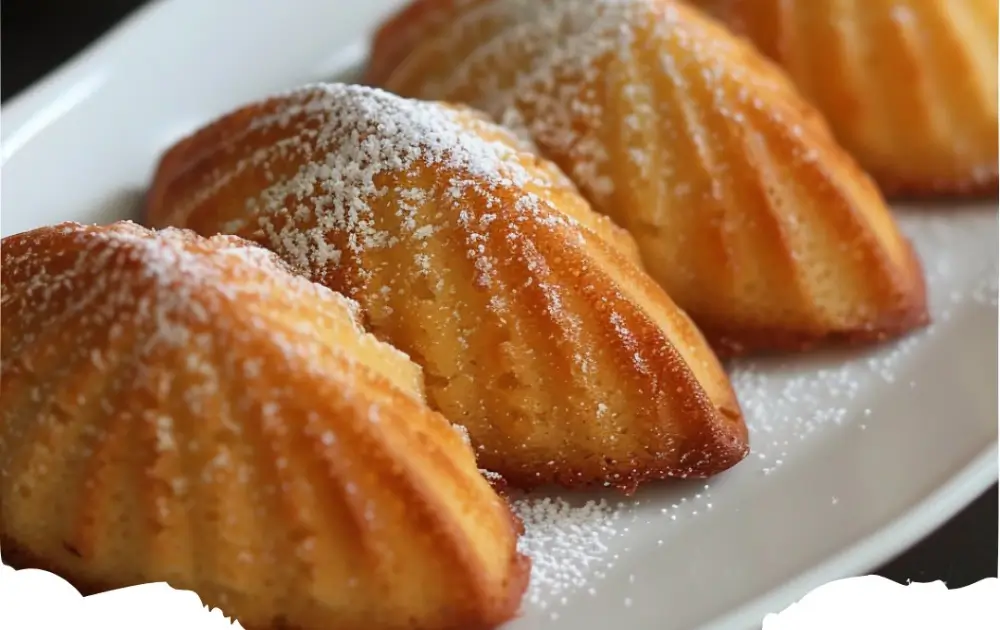Madeleines are a classic French treat that delight with their distinctive shell shape, delicate texture, and light, buttery flavor. These small sponge cakes, often flavored with lemon zest and vanilla, have captivated the hearts of pastry lovers worldwide. Madeleines are perfect for pairing with your afternoon tea or coffee, serving as a refined yet comforting snack.
Print
Madeleines
- Total Time: 27 minutes
- Yield: Makes about 24 madeleines
- Diet: Vegetarian
Description
Madeleines are petite French sponge cakes with a distinctive shell-like shape, known for their light texture and buttery, lemon-flavored crumb. Perfect as an accompaniment to tea or coffee, these elegant treats are a delightful blend of simplicity and sophistication.
Ingredients
▢7 tbsp unsalted butter 100g
▢2 large eggs at room temperature
▢1/2 cup granulated sugar 100g
▢1 teaspoon lemon zest
▢1 teaspoon pure vanilla extract
▢3/4 cup all-purpose flour plus 1 tbsp 100g sifted
▢1/4 teaspoon baking powder
▢1 pinch salt
Instructions
Melt the butter either in your microwave or in a small pot over medium heat. Browning the butter will add a lovely depth or flavor to the cakes but is of course optional. Once melted or browned pour the butter into a bowl and allow to cool.
Sift the flour, salt, and baking powder into a bowl then whisk together and set aside.
Add the eggs and sugar to the bowl or your stand mixer fitted with a whisk attachment or a large bowl if using an electric hand mixer. Beat on high until the mixture is a light yellow color with a thick silky texture, about 8-9 minutes. You’ll see the beater leave trails when it’s ready. Mix in the vanilla and lemon zest toward the end.
Fold the dry ingredients into the egg mixture and mix until just combined. You can sift the flour mixture into the eggs while you fold to avoid getting lumps or over-mixing the delicate batter.
Drizzle the butter into the batter and gently mix until just combined.
Cover and chill the batter as well as the buttered tins for 1 hour then scoop one tablespoon of batter into each scallop-shaped well. Bake at 350F 8-10 minutes.
Serve with a light dusting of powdered sugar.
Notes
- Chilling the batter helps achieve the characteristic “hump” and enhances the cakes’ flavor.
- Be careful not to overmix the batter to maintain a light, airy texture.
- Madeleines are best enjoyed fresh, but can be stored in an airtight container for 1-2 days.
- Prep Time: 15 minutes (plus chilling)
- Cook Time: 12 minutes
- Category: Dessert
- Method: Baking
- Cuisine: French
Nutrition
- Calories: Approximately 80 per madeleine
- Sugar: 5g
- Sodium: 15mg
- Fat: 4.5g
- Carbohydrates: 9g
- Protein: 1g

FAQs About Madeleines
What’s the best way to get the classic “hump” on my madeleines? Achieving the classic “hump” on madeleines typically requires chilling the batter for several hours or overnight before baking. This temperature difference helps create a steam effect in the oven, causing the batter to puff up and form the characteristic bump.
Can I make madeleines without a madeleine pan? While a madeleine pan is ideal for getting the traditional shell shape, you can use a mini muffin tin as an alternative. The texture and flavor will be similar, though the shape will differ from the classic madeleine.
How long do madeleines stay fresh? Madeleines are best enjoyed the day they are made, as they tend to lose their delicate texture and moistness over time. However, you can store them in an airtight container at room temperature for up to two days.
Can madeleines be frozen? Yes, madeleines can be frozen. Place them in a single layer on a baking sheet to freeze individually, then transfer to a freezer-safe bag or container. When ready to enjoy, let them thaw at room temperature or gently reheat them in the oven.
Are there any dairy-free alternatives for madeleines? To make dairy-free madeleines, substitute the butter with a plant-based butter or oil. Keep in mind that this may slightly alter the flavor and texture of the madeleines.
Selecting the Right Ingredients
For the best madeleines, use high-quality ingredients. Start with unsalted butter for a pure, rich taste, and fresh eggs for a light, airy texture. Incorporating finely grated lemon zest adds a subtle brightness that enhances the overall flavor, while pure vanilla extract brings a warm depth. Choosing the right flour is also key—opt for all-purpose flour for its reliable results.
Preparing the Batter
The secret to the perfect madeleine texture lies in the preparation of the batter. Begin by melting the butter and allowing it to cool slightly. In a separate bowl, whisk together eggs, sugar, and a pinch of salt until the mixture is light and frothy. Gently fold in the flour, followed by the cooled melted butter, lemon zest, and vanilla extract, being careful not to overmix and deflate the batter.
Resting the Batter
Allowing the madeleine batter to rest in the refrigerator for at least an hour (or preferably overnight) is crucial. This resting period helps to achieve the characteristic “hump” on the back of each madeleine and enhances the cakes’ flavor. It also ensures the batter is sufficiently firm to hold its shape during baking.
Preparing the Madeleine Pan
A madeleine pan, with its distinctive shell-shaped molds, is essential for giving these cakes their traditional appearance. Brush the molds with melted butter and dust them lightly with flour to ensure the madeleines release easily after baking. Some prefer to use non-stick spray for convenience, but butter adds an extra layer of flavor and richness.
Baking to Perfection
Preheat your oven and fill each mold with the chilled batter, being careful not to overfill. Bake the madeleines until they are golden and spring back when lightly touched. The exact baking time can vary, so keeping an eye on them is important. Once baked, gently tap the pan on the counter to release the madeleines.

Enjoying Madeleines
Madeleines are best enjoyed fresh from the oven, while they are still warm and tender. They can be dusted with powdered sugar for a simple yet elegant finish or dipped in melted chocolate for a decadent treat. Pairing madeleines with tea or coffee not only complements their flavors but also turns a simple snack into a delightful ritual.
Experimenting with Flavors
While traditional madeleines are known for their lemon and vanilla notes, experimenting with different flavors can transform these petite cakes into a variety of delightful treats. Consider adding orange zest, almond extract, or even a dash of espresso powder to the batter for a unique twist. Incorporating finely chopped nuts or dried fruits can also introduce new textures and tastes, making each batch of madeleines a new culinary adventure.
Storing and Keeping Madeleines Fresh
To maintain the freshness of madeleines, store them in an airtight container at room temperature. They are best enjoyed within a day or two of baking, as they tend to lose their delicate texture over time. If you must extend their shelf life, wrapping them individually in plastic wrap before placing them in the container can help preserve their moisture and softness.
Serving Suggestions for Gatherings
Madeleines make an elegant addition to any gathering or special occasion. Arrange them beautifully on a serving platter, perhaps alongside fresh berries or a selection of fine cheeses, to create an inviting display. For more formal events, madeleines can be served as part of a dessert trio, offering guests a taste of refined French baking.
Mastering the Dipping Technique
For those who enjoy a bit of extra indulgence, mastering the art of dipping madeleines in chocolate or other glazes can add a luxurious touch. Melt your choice of chocolate gently, and dip half of each madeleine into the chocolate, letting the excess drip off before placing them on a wire rack to set. This technique not only enhances the flavor but also elevates the visual appeal of these classic cakes.
Celebrating Tradition with Innovation
While staying true to the traditional aspects of madeleine baking, embracing innovation allows bakers to express creativity and personal taste. Whether it’s through the introduction of new flavors, the adaptation of the recipe to accommodate dietary restrictions, or the presentation of the finished cakes, madeleines serve as a versatile canvas for culinary expression. Celebrating the balance between tradition and innovation ensures that the charm of madeleines continues to enchant future generations.
Incorporating Seasonal Ingredients
Embracing the seasons can bring a refreshing twist to your madeleine recipes. Springtime might inspire the addition of fresh berry purees, while autumn calls for pumpkin spice or apple cinnamon madeleines. Using seasonal ingredients not only enhances the flavor profile of these delicate cakes but also connects your baking to the natural world, offering a timely and tasteful reflection of each season.

Creative Presentation Ideas
Presentation plays a significant role in elevating the overall enjoyment of madeleines. For a visually stunning arrangement, layer madeleines alternately with fruits or edible flowers on a tiered cake stand. For a more thematic approach, tailor your presentation to match the occasion, such as arranging them in a heart shape for Valentine’s Day or as part of a festive holiday spread.
Hosting Madeleine-Themed Parties
A madeleine-themed party can be a delightful way to share your love for these French confections with friends and family. Invite guests to a tasting party where they can sample a variety of madeleine flavors. Consider setting up a decorating station where guests can dip madeleines in chocolate and adorn them with sprinkles, nuts, or drizzles, turning the event into an interactive and memorable experience.
Adapting Madeleines for Special Diets
Adapting madeleine recipes to cater to special diets ensures everyone can enjoy these treats. Gluten-free flour blends can substitute all-purpose flour without compromising texture, while plant-based milks and egg replacements allow vegans to savor madeleines. Experimenting with alternative ingredients not only broadens the appeal of madeleines but also showcases their versatility in accommodating dietary preferences.
The Art of Gifting Madeleines
Madeleines, with their elegant appearance and delightful taste, make exquisite gifts. Package them in clear cellophane bags tied with a ribbon or in custom-made boxes for a personal touch. Including a handwritten note or recipe card adds a thoughtful element, making the gift of madeleines a sweet gesture that celebrates the joy of baking and the warmth of sharing.
Enhancing Madeleines with Infusions
To add depth and complexity to madeleines, consider infusing the butter with flavors such as lavender, rosemary, or Earl Grey tea. Melting the butter with these aromatic ingredients and allowing it to steep before straining adds subtle undertones that can make each bite a sensory experience. This method of flavor enhancement showcases the ability of madeleines to serve as a delicate canvas for culinary creativity.
Leveraging Madeleines in Dessert Compositions
Madeleines can play a starring role in more elaborate dessert compositions. Crumbled madeleine pieces can be layered with mousses, fresh fruits, and whipped cream to create luxurious trifles. Alternatively, use whole madeleines to add structure and sophistication to parfaits or as the base for deconstructed dessert canapés, demonstrating their versatility beyond the tea tray.
Cultivating a Madeleine Baking Community
Building a community around the love for baking madeleines can be both fulfilling and inspiring. Organize baking clubs, online forums, or social media groups where enthusiasts can share recipes, tips, and photos of their creations. Hosting madeleine bake-offs or challenges encourages members to experiment with new flavors and techniques, fostering a sense of camaraderie and collective exploration in the art of madeleine making.
Exploring International Variants
While madeleines are quintessentially French, exploring international variants can broaden one’s appreciation for similar treats around the world. Dishes like the Italian “Madeleine” cookies or the Spanish magdalenas share similarities with the French classic but often feature regional ingredients and distinct textures. Experimenting with these variants not only enriches one’s baking repertoire but also offers insight into how different cultures embrace and adapt the concept of the madeleine.
Mastering Madeleine Photography
In today’s digital age, mastering the art of photographing madeleines can enhance their appeal and share your culinary achievements with a wider audience. Use natural light to highlight their golden hue and texture, and experiment with props and backgrounds to tell a story or convey a mood. Sharing these images on social media or culinary blogs not only showcases your skill but also inspires others to discover the joys of madeleine baking.

Conclusion
Madeleines, with their delicate crumb and elegant shell shape, continue to be a beloved treat for their simplicity and versatility. From classic lemon-scented madeleines to adventurous flavor infusions, there’s a madeleine for every palate. Whether you’re perfecting the iconic hump, exploring international variations, or sharing your creations with a community of fellow bakers, the world of madeleines offers endless possibilities for culinary creativity. Embrace the process, experiment with new ideas, and most importantly, enjoy the delightful experience of baking and savoring these exquisite French cakes.

